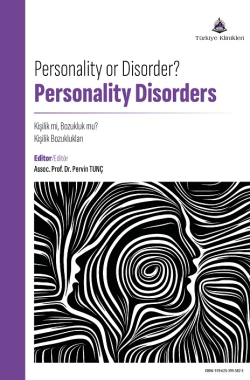Borderline Personality Disorder
Zeynep ANAFOROĞLU BIKMAZa
aİstinye University Institute of Graduate Education, Department of Clinical Psychology, İstanbul, Türkiye
Anaforoğlu Bıkmaz Z. Borderline personality disorder Tunç P, ed. Personality or Disorder? Personality Disorders. 1st ed. Ankara: Türkiye Klinikleri; 2025. p.35-46.
ABSTRACT
A comprehensive understanding of Borderline Personality Disorder (BPD) necessitates an in-depth examination of its theoretical foundations, particularly from the perspectives of psychodynamic and object relations theories. These approaches emphasize how early relational experiences shape personality development and contribute to the emotional and interpersonal fluctuations observed in individuals with BPD. This article explores the historical evolution, epidemiology, DSMV classification, etiological factors, and explanatory models of BPD. Within a psychodynamic framework, it analyzes the organization of personality in BPD, defense mechanisms, and its relationship with object relations theory. Integrating these fundamental aspects is expected to enhance our understanding of BPD’s development and inform therapeutic approaches.
Keywords: Borderline personality disorder; psychodynamic features; object relations; defense mechanisms
Kaynak Göster
Referanslar
- Links PS, Ross J. Good Psychiatric Management of Borderline Personality Disorder: Foundations and Future Challenges. Am J Psychother, 2024. [Crossref] [PubMed]
- Flaskerud JH. Temperament and personality: from Galen to DSM 5. Issues Ment Health Nurs. 2012;33(9):631-4. [Crossref] [PubMed]
- Ogunc NE, Eren N. Effects of the psychodynamic group psychotherapy process on object relations for patients with borderline personality disorder. Journal of Psychiatric Nursing. 2012;3(1):30-8. [Crossref]
- Black DW, Grant JE. DSM-5® guidebook: the essential companion to the diagnostic and statistical manual of mental disorders. 2014.
- Paris J. Borderline personality disorder: A multidimensional approach. American Psychiatric Pub;, 1994. [Crossref]
- Stern A. Psychoanalytic investigation of and therapy in the border line group of neuroses. The Psychoanalytic Quarterly. 1938;7(4):467-89. [Crossref]
- Kernberg O. Borderline personality organization. J Am Psychoanal Assoc. 1967;15(3):641-85. [Crossref] [PubMed]
- Waldinger RJ, Gunderson JG. Completed psychotherapies with borderline patients. American Journal of Psychotherapy. 1984;38(2):190-202. [Crossref] [PubMed]
- Skodol AE, Bender DS. Why are women diagnosed borderline more than men? Psychiatric Quarterly. 2003;74:349-60. [Crossref] [PubMed]
- Linehan MM. Dialectical behavior therapy for treatment of borderline personality disorder: implications for the treatment of substance abuse. NIDA research monograph. 1993;137:201. [Crossref]
- Fonagy P, Bateman A. The development of borderline personality disorder a mentalizing model. J Pers Disord. 2008;22(1):4-21. [Crossref] [PubMed]
- Chapman J, Jamil RT, Fleisher C, Torrico TJ. Borderline Personality Disorder. In StatPearls. 2024.
- Schore AN. Back to basics: Attachment, affect regulation, and the developing right brain: Linking developmental neuroscience to pediatrics. Pediatrics. 2005;26(6):204-17.
- Leichsenring F, Heim N, Leweke F, Spitzer C, Steinert C, Kernberg OF. Borderline Personality Disorder: A Review. JAMA. 2023;329(8):670-9. [Crossref] [PubMed]
- Fonagy P, Luyten P, Bateman A. Treating Borderline Personality Disorder With Psychotherapy: Where Do We Go From Here? JAMA Psychiatry. 2017;74(4):316-7. [Crossref] [PubMed]
- Mahler MS. On the first three subphases of the separation-individuation process. Essential papers on object relations. 1986;222-32.
- Smith R, Killgore WD, Lane RD. The structure of emotional experience and its relation to trait emotional awareness: A theoretical review. Emotion. 2018;18(5):670. [Crossref] [PubMed]
- Glass IV, Frankenburg FR, Zanarini MC. Longitudinal description and prediction of physical inactivity among patients with borderline personality disorder and personality-disordered comparison subjects. Borderline Personal Disord Emot Dysregul. 2024;11(1):11. [Crossref] [PubMed] [PMC]
- Stern DN. The early development of schemas of self, other, and "self with other". In Reflections on self psychology (psychology revivals). 2014;49-84.
- Gunderson JG, Lyons-Ruth K. BPD's interpersonal hypersensitivity phenotype: A gene-environment-developmental model. Journal of personality disorders. 2008;22(1):22-41. [Crossref] [PubMed] [PMC]
- Monti MR, D'Agostino A. Borderline personality disorder from a psychopathological-dynamic perspective. Journal of psychopathology. 2014;20(4):451-60.
- Kernberg OF. Prognostic considerations regarding borderline personality organization. J Am Psychoanal Assoc. 1971;19(4):595-635. [Crossref] [PubMed]
- Gabbard GO. Psychodynamic psychiatry in clinical practice. American Psychiatric Pub, 2014. [Crossref]
- Kernberg OF. What is personality? Journal of personality disorders. 2016;30(2):145-56. [Crossref] [PubMed]
- Freud S. The ego and the id (1923). Tacd Journal. 1989;17(1):5-22. [Crossref]
- Hartmann H. Comments on the psychoanalytic theory of the ego. The Psychoanalytic Study of the Child. 1950;5(1):74-96. [Crossref]
- Fonagy P, Allison E. What is mentalization? The concept and its foundations in developmental research. Minding the child: Mentalization-based interventions with children, young people and their families. 2012;11-34.
- Sheikh FA. Subjectivity, desire and theory: Reading Lacan. Cogent Arts & Humanities. 2017;4(1):1299565. [Crossref]
- Green A. The analyst, symbolization and absence in the analytic setting (on changes in analytic practice and analytic experience) in memory of DW Winnicott. Int J Psychoanal. 1975;56(1):1-22.
- Bowins B. Personality disorders: a dimensional defense mechanism approach. Am J Psychother. 2010;64(2):153-69. [Crossref] [PubMed]
- Phillips A. Winnicott. UK: Penguin Books Ltd; 2007.
- Mayer JD. A systems framework for the field personality. Psychological Inquiry. 1998;9(2):118-44. [Crossref]
- McIntosh D. The ego and the self in the thought of Sigmund Freud. The International Journal of Psycho-Analysis. 1986;67:429.
- Anderson MK. Should We Be Stern With Daniel Stern? A Personal Appraisal of Daniel Stern's Book The Interpersonal World of the Infant'. British Journal of Psychotherapy. 1992;9(1):33-9. [Crossref]
- Edwards WL. Predicting conceptual level of object representation from adult attachment criteria: An exploration of object relations theory and attachment theory. The University of Texas at Austin. 1993.
- Meehan W. The idea of the reflexive unconscious in drive and object relations theory The Wright Institute; 1999.
- Ogden TH. The analytic third: Working with intersubjective clinical facts. In The Analytic Field. 2018;159-88. [Crossref]
- Lombardi R. Primitive mental states and the body: A personal view of Armando B. Ferrari's concrete original object. The International Journal of Psychoanalysis. 2002;83(2):363-81. [Crossref]

